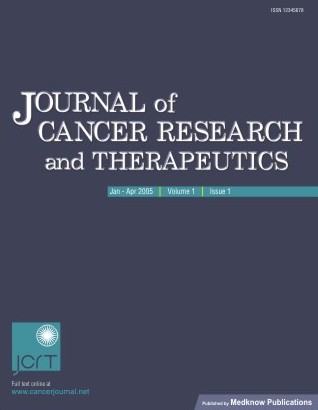
|
Journal of Cancer Research and Therapeutics
Medknow Publications on behalf of the Association of Radiation Oncologists of India (AROI)
ISSN: 0973-1482 EISSN: 1998-4138
Vol. 6, Num. 3, 2010, pp. 407-408
|
Journal of Cancer Research and Therapeutics, Vol. 6, No. 3, July-September, 2010, pp. 407-408
Book Review
Handbook of Cancer Models with Applications
CR Sridhar
Ph.D (Operations Research), Fellow - Royal Statistical Society, President: Nuvis Anlytics Pvt Ltd, India
Correspondence Address:C R Sridhar,
Ph.D (Operations Research), Fellow - Royal Statistical Society, President: Nuvis
Anlytics Pvt Ltd, India,
Sridhar.cr@gmail.com
Code Number: cr10106
Editor in Chief: Wai-Yuan Tan and Leonid Henin
Publishers: World Scientific 2008
The handbook is a collection of papers by practitioners and academics in cancer research. It covers carcinogenesis, progression, metastasis and post-treatment stages of cancer in considerable detail, using mathematical and statistical models. The models treated in this book vary from simple tree structures to complex wavelet structures. Cancer Modeling usually refers to mathematical modeling of biological theories and testing them using cancer data. The modeling is essential for uncovering the patterns behind clinical data for efficient diagnostic, controlling, curative and preventive strategies. The modeling process is slow because of the nature of data and tends to be complex because of the nature of cancer. Most models primarily use a frame work of "multi-stage and multiple pathway" for carcinogenesis and propagation. This volume is divided into two parts. The first part details an assortment of cancer models and the second part deals with applications of cancer models. In the first part of the handbook, Kim Thom Jung revisits the major epigenetic hypotheses of carcinogenesis. The hypotheses that he revisits are The Warburg′s, Linus Pauling, Szent-Gyorgyi, micronutrients, NAD deficiency, Gap Junction Intercellular Communication and Viral Infections. This paper is an excellent introduction to the current thinking on epigenetic issues in carcinogenesis. A quick survey on cancer modeling is presented by Wai Y Tan et al. The papers discuss models to address the multistage process of carcinogenesis, using Bayesian procedures, mixed and state-space models, and stochastic differential equations. A topic of considerable interest here is that of Gibbs Sampling. This sampling technique is extremely useful in cancer modeling where the size of data quite often becomes an issue. The range of models presented here reflects the complexities involved in cancer modeling. Given the multistage nature of cancer, even very sophisticated models can be at best approximations. An interesting application of the state-space model uses the British physician′s data on smoking and lung cancer. One of the simplest and well-documented models is the Two-Stage Clonal Expansion Model (TSCE) of Moolgavkar et al. William Hazelton extends the model to a multistage framework to analyze the effects of radiation and chemical exposure. This model could be of considerable interest to many researchers. Qi Zeng uses the hazard function to demonstrate its usefulness in modeling cancer progression. Hazard function and its complement survival function have applications in multiple situations. An extension of multistage model is the multiple pathways model. In this chapter, the multistage model of Armitage and Doll, and the TSCE model of Moolgavkar, and Knudesen are discussed and the need to generalize them to multiple pathways is presented. The data used are that of radiation effects on carcinogenesis and progression. Leonid Hanin formulates a model for metastasis, using a non-homogeneous Poisson process. This is by and large the only paper that addresses the tumor growth through a time-dependent process. The sequential occurrence of genetic abnormalities in carcinogenesis is modeled through oncogenetic trees by Szabo and Boucher. Three articles would be of considerable interest to researchers in radiation effects. Robert Stewart and Semenenko give a brief review of radiation-induced DNA damage and they detail a model that presents the trends in mutagenesis as a function of dose and particle. Linda DeVeaux reviews the bystander effect on cells that are not radiated. Wai Tan et al. present a very detailed paper for carcinogenesis using a biologically supported model. This is a state-space model that uses stochastic difference equations and is illustrated with a case. The process of formation and growth of precursor lesions is described by Annette et al. using data from animal experiments. The model makes use of Poisson process to model birth and death of cells. The last four chapters of the book do not address cancer modeling directly but address issues related to cancer. Mathematical modeling in chemotherapy has been difficult because of resistance of cancer cells to cytotoxic agents. Smieja discusses the drug resistance problem in chemotherapy and uses an optimization algorithm to identify the best protocol. Lihong Lee and others discuss the utility of virtual cystoscopy (VC). The authors present a novel computeraided diagnosis (CAD) based system for extracting MRI images. The paper by Don Hong and Yu Shyr is on processing proteomic data. The analysis of genomic complements of proteins in cancer research is recent. The data from mass spectrographs are used in this paper for application of wavelets theory to extract the correct information from mass spectrometry (MS) data. The design and analysis of xenograft experiments for drug development is an important tool, and Tan and Fang discuss in their paper, a class of multivariate models for handling missing data. In the last paper of this book, by Sesh Rai, the focus is on missing or incomplete data. Incomplete data sets are a common occurrence in most research studies. However, there are data that are critical but unobservable. Two examples have been detailed in the paper: Benzyl Acetate and Liver Tumor, and occurrence of glomerulosclerosis due to low level radiation. The handbook is an excellent resource for understanding applications of a variety of models, statistical and stochastic, in different areas of cancer research. Understanding and application of these models demands considerable mathematical and statistical skills. It would have been better had the editors included one or two papers on new developments in mathematical software for medical research.
Copyright 2010 - Journal of Cancer Research and Therapeutics
| 